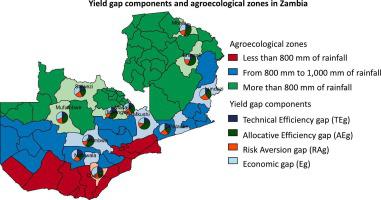Agricultural Systems ( IF 6.6 ) Pub Date : 2023-04-05 , DOI: 10.1016/j.agsy.2023.103657 Nicolas Gatti , Michael Cecil , Kathy Baylis , Lyndon Estes , Jordan Blekking , Thomas Heckelei , Noemi Vergopolan , Tom Evans

|
CONTEXT
Sub-Saharan Africa (SSA) has the climatic and biophysical potential to grow the crops it needs to meet rapidly growing food demand; however, agricultural productivity remains low. While potential maize yields in Zambia are 9 t per hectare (t/ha), the average farmer produces only 1–2.
OBJECTIVE
We evaluate the contribution of responses to weather risk to that gap by decomposing the yield gap in maize in Zambia. While we know that improved seed and fertilizer can expand yield and profit, they may also increase the variance of yield under different weather outcomes, reducing their adoption.
METHODS
We use a novel approach combining crop modeling and statistical analysis of survey data to obtain the yield gap components in Zambia driven by input cost and input risk. We use a crop model to simulate district-level marginal effects of fertilizer and seed maturity choice on the mean and variance of expected yield and profit under all-weather outcomes for each district for the past 30 years. We compare input levels that maximize expected yield to those that maximize expected profit and maximize the expected mean-variance trade-off assuming risk-aversion. To determine how much farmers' input choices are made to reduce risk, we then quantify differences in the expected riskiness of inputs by district.
RESULTS AND CONCLUSIONS
We find approximately one-quarter of the yield gap can be explained by risk-reducing behavior, albeit with a substantial geographic variation. Given this finding, under present conditions, we expect that the average maximum yield that farmers can obtain without increasing risk is 6.75 t/ha compared to a potential profit-maximizing level of 8.84 t/ha.
SIGNIFICANCE
The risk-related yield gap is only expected to increase with weather extremes driven by climate change. Promoting “one-size-fits all” solutions to closing the yield gap could underestimate the effect of risk mitigation on agricultural production while increasing farmers' risk exposure.
中文翻译:

缩小农业产量差距是一项“冒险”的努力吗?
语境
撒哈拉以南非洲 (SSA) 拥有种植所需作物以满足快速增长的粮食需求的气候和生物物理潜力;然而,农业生产力仍然很低。虽然赞比亚的潜在玉米产量为每公顷 9 吨 (t/ha),但农民的平均产量仅为 1-2 吨。
客观的
我们通过分解赞比亚玉米的产量差距来评估对天气风险的反应对该差距的贡献。虽然我们知道改良种子和肥料可以提高产量和利润,但它们也可能会增加不同天气结果下产量的差异,从而减少它们的采用。
方法
我们使用一种结合作物建模和调查数据统计分析的新方法来获得赞比亚由投入成本和投入风险驱动的产量差距组成部分。我们使用作物模型来模拟肥料和种子成熟度选择对过去 30 年每个地区全天候结果下预期产量和利润均值和方差的地区级边际效应。我们将最大化预期收益的投入水平与最大化预期利润的投入水平进行比较,并在假设风险厌恶的情况下最大化预期均值-方差权衡。为了确定农民为降低风险而做出的投入选择,我们随后量化了各地区投入的预期风险差异。
结果和结论
我们发现大约四分之一的收益率差距可以用降低风险的行为来解释,尽管存在很大的地域差异。鉴于这一发现,在目前的条件下,我们预计农民在不增加风险的情况下可以获得的平均最大产量为 6.75 吨/公顷,而潜在利润最大化水平为 8.84 吨/公顷。
意义
与风险相关的收益率差距预计只会随着气候变化导致的极端天气而增加。推广“一刀切”的解决方案来缩小产量差距可能会低估风险缓解对农业生产的影响,同时增加农民的风险敞口。


























 京公网安备 11010802027423号
京公网安备 11010802027423号